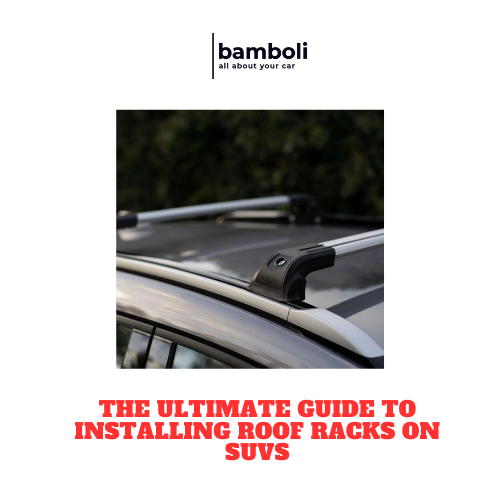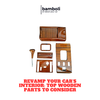The Ultimate Guide to Installing Roof Racks on SUVs

The Ultimate Guide to Installing Roof Racks on SUVs
Installing a roof rack on your SUV opens up a world of possibilities for outdoor adventures and long road trips. It provides additional storage space for gear, luggage, and sports equipment, making your vehicle more versatile and functional. However, the installation process can be daunting if you're not familiar with the steps. This ultimate guide will walk you through the process, ensuring you have the tools, knowledge, and confidence to install your roof rack correctly.
Why Install a Roof Rack on Your SUV?
Before diving into the installation process, let's explore the benefits of installing a roof rack on your SUV:
- Increased Storage: Roof racks allow you to carry more gear, freeing up interior space for passengers.
- Versatility: Perfect for transporting bikes, kayaks, skis, cargo boxes, and more.
- Convenience: Easy access to your equipment, making loading and unloading hassle-free.
- Enhanced Adventure: Ideal for outdoor enthusiasts, making it easier to bring along all necessary gear.
Tools and Materials Needed
To ensure a smooth installation process, gather the following tools and materials:
- Roof Rack Kit: Ensure it’s compatible with your SUV model.
- Measuring Tape: For accurate measurements.
- Marker or Pencil: To mark installation points.
- Screwdriver or Allen Wrench: Depending on the roof rack's hardware.
- Rubber Mallet: To gently tap components into place.
- Ladder: To reach the roof of your SUV comfortably.
- Torque Wrench: To ensure bolts are tightened to the manufacturer’s specifications.
Step-by-Step Installation Guide
Step 1: Preparation
- Read the Manual: Start by thoroughly reading the roof rack's installation manual. This will provide specific instructions and safety information for your particular model.
- Clean the Roof: Ensure the roof of your SUV is clean and dry to prevent any damage or interference during installation.
Step 2: Measure and Mark
- Position the Rack: Place the roof rack on the roof of your SUV to determine the best position. Ensure it's centered and aligned with the vehicle’s roof.
- Measure Distance: Use a measuring tape to ensure equal distance from the front and rear of the vehicle. This helps in balancing the load.
- Mark Points: Mark the points where the roof rack will be attached. Use a marker or pencil for accuracy.
Step 3: Install the Mounting Brackets
- Align Brackets: Position the mounting brackets according to the marked points. Ensure they are aligned correctly.
- Secure Brackets: Using the provided hardware, secure the brackets to the roof. Tighten the screws or bolts with a screwdriver or Allen wrench.
- Double-Check Alignment: Before fully tightening, double-check the alignment of the brackets.
Step 4: Attach the Crossbars
- Position Crossbars: Place the crossbars onto the mounted brackets. Ensure they are evenly spaced and aligned.
- Secure Crossbars: Use the provided hardware to secure the crossbars to the brackets. A torque wrench can be used to ensure the bolts are tightened to the manufacturer’s specifications.
- Tap Gently: If necessary, use a rubber mallet to gently tap the crossbars into place.
Step 5: Final Adjustments
- Check Stability: Ensure the roof rack is stable and securely attached. Wiggle it gently to check for any movement.
- Tighten Bolts: Go over all bolts and screws again to ensure they are tight and secure.
- Safety Check: Perform a final safety check, ensuring all components are securely fastened and there are no loose parts.
Tips for a Successful Installation
- Follow Instructions: Always follow the manufacturer’s instructions for specific details and safety information.
- Use Quality Tools: High-quality tools can make the installation process smoother and more efficient.
- Work with a Partner: Having an extra set of hands can help with positioning and securing the roof rack.
- Avoid Over-Tightening: Be cautious not to over-tighten bolts, as this can damage the components or the roof of your SUV.
- Regular Maintenance: Periodically check the roof rack for tightness and wear, especially before long trips.
Comparison Table: Rubber vs. Plastic Boot Liners
|
Feature |
Rubber Boot Liners |
Plastic Boot Liners |
|
Durability |
Highly durable, flexible |
Durable but can be brittle in cold |
|
Weight |
Heavier |
Lightweight |
|
Cleaning |
Easy with water and soap |
Easy, waterproof |
|
Surface Grip |
Non-slip surface |
Slippery, items may shift |
|
Odor |
May emit odor initially |
Generally odorless |
|
Cost |
Generally more expensive |
More affordable |
|
Installation |
Snug fit, flexible installation |
Rigid structure, straightforward |
Maximizing the Use of Your Roof Rack
Once your roof rack is installed, maximize its benefits with these tips:
- Use Roof Boxes: For additional storage space, consider using roof boxes that can be securely attached to the rack.
- Secure Loads Properly: Always use appropriate straps and tie-downs to secure your cargo.
- Distribute Weight Evenly: Ensure that the load is evenly distributed to maintain vehicle balance and stability.
- Check Clearance: Be mindful of the added height when driving under low bridges, parking garages, and other overhead obstacles.
Maintenance Tips
To ensure your roof rack stays in good condition and continues to function effectively, follow these maintenance tips:
Regular Inspections: Periodically inspect the roof rack for any signs of wear, damage, or loose bolts. Address any issues immediately to prevent further damage.
Cleaning: Keep the roof rack clean by washing it with mild soap and water. This prevents dirt and debris buildup that could cause wear over time.
Lubrication: Apply lubricant to moving parts, such as hinges and locks, to ensure smooth operation and prevent rust.
Protection: If you live in an area with harsh weather conditions, consider using a protective cover for your roof rack when not in use. This helps prevent corrosion and extends the life of the rack.
Additional Accessories for Roof Racks
Enhance the functionality of your roof rack with these additional accessories:
- Roof Baskets: Provide extra storage space for irregularly shaped items.
- Bike Racks: Securely transport bicycles without taking up interior space.
- Kayak Carriers: Safely transport kayaks and canoes.
- Cargo Nets: Ensure loose items are securely fastened and prevent them from shifting during transit.
Choosing the Right Roof Rack for Your Needs
Selecting the right roof rack involves considering your specific needs and vehicle type. Here are some factors to keep in mind:
- Vehicle Compatibility: Ensure the roof rack is designed to fit your SUV model.
- Load Capacity: Choose a rack that can support the weight of the items you plan to carry.
- Ease of Installation: Consider how easy it is to install and remove the roof rack.
- Durability: Look for high-quality materials that can withstand the elements and heavy use.
- Aerodynamics: Some roof racks are designed to reduce wind resistance, which can improve fuel efficiency and reduce noise.
Making the Most of Your Roof Rack
By following this guide, you can successfully install a roof rack on your SUV and maximize its benefits. Whether you’re gearing up for a camping trip, a biking adventure, or simply need extra storage for your daily commute, a well-installed roof rack can make all the difference. Remember to regularly maintain your roof rack to ensure it remains in top condition, providing reliable performance for years to come.
Frequently Asked Questions
Can I install a roof rack on any SUV? Most SUVs can accommodate roof racks, but it’s essential to choose a rack that’s compatible with your specific model. Check the manufacturer’s specifications before purchasing.
How much weight can a roof rack support? The weight capacity varies by roof rack and SUV model. Always check the manufacturer’s guidelines for the maximum load capacity and avoid exceeding it.
Do I need a professional to install a roof rack? While many roof racks can be installed by the user, professional installation ensures a secure fit and can prevent potential damage during the process.
How do I prevent wind noise with a roof rack? Ensure the roof rack is properly installed and all components are secure. Some roof racks come with wind deflectors to reduce noise.
Can I leave the roof rack on my SUV permanently? Yes, you can leave the roof rack on your SUV. However, regularly check for tightness and wear, and remove it if not in use for an extended period to save on fuel efficiency.




